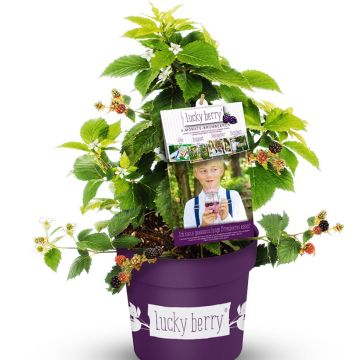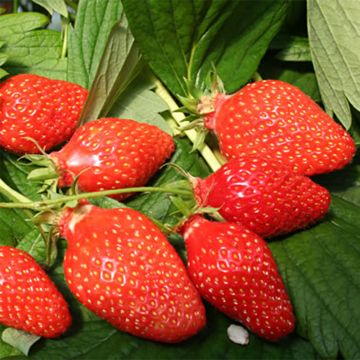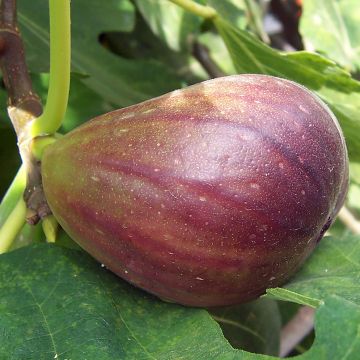

Rubus fruticosus 'Navaho Big and Early'
Rubus fruticosus 'Navaho Big and Early'
Rubus fruticosus Navaho® Big and Early®
Blackberry, Bramble
Special offer!
Receive a €20 voucher for any order over €90 (excluding delivery costs, credit notes, and plastic-free options)!
1- Add your favorite plants to your cart.
2- Once you have reached €90, confirm your order (you can even choose the delivery date!).
3- As soon as your order is shipped, you will receive an email containing your voucher code, valid for 3 months (90 days).
Your voucher is unique and can only be used once, for any order with a minimum value of €20, excluding delivery costs.
Can be combined with other current offers, non-divisible and non-refundable.
Why not try an alternative variety in stock?
View all →This plant carries a 6 months recovery warranty
More information
We guarantee the quality of our plants for a full growing cycle, and will replace at our expense any plant that fails to recover under normal climatic and planting conditions.
Description
The 'Navaho Big and Early' blackberry is a productive and thornless variety appreciated for its large, juicy, sweet fruits and earliness. These are the first blackberries to be picked from early July. Its black and shiny fruits are twice as large as those of the original variety 'Navaho'. They can be enjoyed fresh or cooked in compote, pie or jam. It is a vigorous, healthy, self-fertile plant with upright branches. You can train them or tie them to a post. It is hardy and not very demanding when planted in sunny, not too dry soil.
From the Rosaceae family, Rubus fructicosus 'Navaho Big and Early' is a selection of the 'Navaho' variety created by Lubera AG. It is a thornless bush with an upright habit. Its branches grow vertically, which significantly reduces its bulk. You can train its branches as they grow on a post or trellis. It generally reaches 2 to 3 m (7 to 10ft) in height.
Deciduous, the plant loses its leaves in autumn. In spring, it bears cup-shaped flowers with five pinkish-white to pink petals. Its abundant and melliferous flowering takes place in June and early July. Large black and shiny blackberries follow this. Each fruit can weigh between 6 and 7g. They are both firm and melting in the mouth. Sweet, juicy and fragrant, they can be consumed fresh or made into jam, compote or pie.
The harvest extends throughout July. It is one of the first blackberries in the garden.
Self-fertile, it does not need a partner to bear fruit and is particularly productive. Each plant can yield between 2 and 4 kg of fruit.
In the garden, this thornless blackberry naturally finds its place in the orchard with other fruit trees. It can be trained on a post and easily fit into a small garden. It is also ideal in a rustic and edible hedge alongside 'Smokey' serviceberries with blue and sweet berries and male dogwoods with red and edible fruits.
Report an error about the product description
Rubus fruticosus 'Navaho Big and Early' in pictures


Plant habit
Fruit
Flowering
Foliage
Botanical data
Rubus
fruticosus
Navaho® Big and Early®
Rosaceae
Blackberry, Bramble
Cultivar or hybrid
Other Blackberry bush
View all →Planting and care
Plant the 'Navaho Big and Early' Thornless Blackberry, ideally in full sun or partial shade. It will be more productive if it benefits from good sunlight. It appreciates deep, fertile, and rather moist soil. It is a low-maintenance plant that will be satisfied with ordinary soil that is not too dry. Self-fertile, its production is more abundant if another variety is planted nearby. Plan to trellis or tie the new shoots as they grow.
Planting period
Intended location
Care
This item has not been reviewed yet - be the first to leave a review about it.
Similar products
Haven't found what you were looking for?
Hardiness is the lowest winter temperature a plant can endure without suffering serious damage or even dying. However, hardiness is affected by location (a sheltered area, such as a patio), protection (winter cover) and soil type (hardiness is improved by well-drained soil).

Photo Sharing Terms & Conditions
In order to encourage gardeners to interact and share their experiences, Promesse de fleurs offers various media enabling content to be uploaded onto its Site - in particular via the ‘Photo sharing’ module.
The User agrees to refrain from:
- Posting any content that is illegal, prejudicial, insulting, racist, inciteful to hatred, revisionist, contrary to public decency, that infringes on privacy or on the privacy rights of third parties, in particular the publicity rights of persons and goods, intellectual property rights, or the right to privacy.
- Submitting content on behalf of a third party;
- Impersonate the identity of a third party and/or publish any personal information about a third party;
In general, the User undertakes to refrain from any unethical behaviour.
All Content (in particular text, comments, files, images, photos, videos, creative works, etc.), which may be subject to property or intellectual property rights, image or other private rights, shall remain the property of the User, subject to the limited rights granted by the terms of the licence granted by Promesse de fleurs as stated below. Users are at liberty to publish or not to publish such Content on the Site, notably via the ‘Photo Sharing’ facility, and accept that this Content shall be made public and freely accessible, notably on the Internet.
Users further acknowledge, undertake to have ,and guarantee that they hold all necessary rights and permissions to publish such material on the Site, in particular with regard to the legislation in force pertaining to any privacy, property, intellectual property, image, or contractual rights, or rights of any other nature. By publishing such Content on the Site, Users acknowledge accepting full liability as publishers of the Content within the meaning of the law, and grant Promesse de fleurs, free of charge, an inclusive, worldwide licence for the said Content for the entire duration of its publication, including all reproduction, representation, up/downloading, displaying, performing, transmission, and storage rights.
Users also grant permission for their name to be linked to the Content and accept that this link may not always be made available.
By engaging in posting material, Users consent to their Content becoming automatically accessible on the Internet, in particular on other sites and/or blogs and/or web pages of the Promesse de fleurs site, including in particular social pages and the Promesse de fleurs catalogue.
Users may secure the removal of entrusted content free of charge by issuing a simple request via our contact form.
The flowering period indicated on our website applies to countries and regions located in USDA zone 8 (France, the United Kingdom, Ireland, the Netherlands, etc.)
It will vary according to where you live:
- In zones 9 to 10 (Italy, Spain, Greece, etc.), flowering will occur about 2 to 4 weeks earlier.
- In zones 6 to 7 (Germany, Poland, Slovenia, and lower mountainous regions), flowering will be delayed by 2 to 3 weeks.
- In zone 5 (Central Europe, Scandinavia), blooming will be delayed by 3 to 5 weeks.
In temperate climates, pruning of spring-flowering shrubs (forsythia, spireas, etc.) should be done just after flowering.
Pruning of summer-flowering shrubs (Indian Lilac, Perovskia, etc.) can be done in winter or spring.
In cold regions as well as with frost-sensitive plants, avoid pruning too early when severe frosts may still occur.
The planting period indicated on our website applies to countries and regions located in USDA zone 8 (France, United Kingdom, Ireland, Netherlands).
It will vary according to where you live:
- In Mediterranean zones (Marseille, Madrid, Milan, etc.), autumn and winter are the best planting periods.
- In continental zones (Strasbourg, Munich, Vienna, etc.), delay planting by 2 to 3 weeks in spring and bring it forward by 2 to 4 weeks in autumn.
- In mountainous regions (the Alps, Pyrenees, Carpathians, etc.), it is best to plant in late spring (May-June) or late summer (August-September).
The harvesting period indicated on our website applies to countries and regions in USDA zone 8 (France, England, Ireland, the Netherlands).
In colder areas (Scandinavia, Poland, Austria...) fruit and vegetable harvests are likely to be delayed by 3-4 weeks.
In warmer areas (Italy, Spain, Greece, etc.), harvesting will probably take place earlier, depending on weather conditions.
The sowing periods indicated on our website apply to countries and regions within USDA Zone 8 (France, UK, Ireland, Netherlands).
In colder areas (Scandinavia, Poland, Austria...), delay any outdoor sowing by 3-4 weeks, or sow under glass.
In warmer climes (Italy, Spain, Greece, etc.), bring outdoor sowing forward by a few weeks.



















































